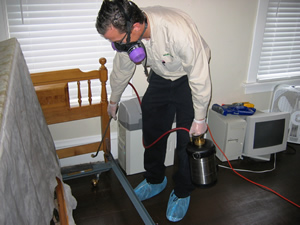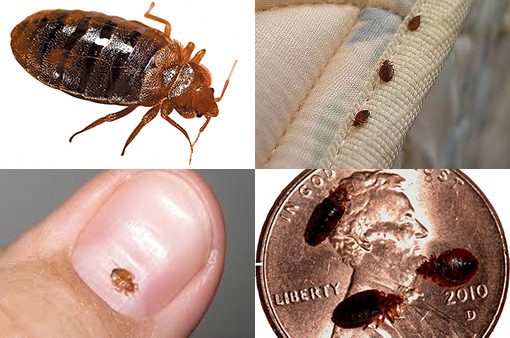Top-Rated Bed Bug Exterminator: DC Exterminator for Effective Treatment
Wiki Article
Discovering the Scientific Research Behind Bed Bug Warmth Treatments as a Sustainable Parasite Administration Strategy
One such method that has acquired grip in recent years is the use of warm therapies to battle bed pest infestations. The complexities of exactly how warmth effectively eliminates bed insects and the wider ramifications for lasting insect administration techniques make this a subject worth discovering better.Bed Pest Warmth Therapy Process

Thermal Fatality Point for Bed Insects
Exposing bed pests to elevated temperature levels beyond their thermal resistance variety is crucial for attaining effective obliteration in warm therapy processes. The thermal fatality factor for bed insects describes the temperature at which these parasites can not make it through. Study indicates that bed pests start to die when subjected to temperature levels above 113 ° F(45 ° C) for a continual period. As the temperature raises, so does the mortality rate of bed bugs. At around 118 ° F(48 ° C ), bed insects start to die quickly, with a death rate of almost 99% within mins of exposure. This demonstrates the level of sensitivity of bed bugs to high temperatures and highlights the performance of heat treatments in getting rid of problems. By reaching and keeping temperature levels above the thermal death point for bed pests, parasite management experts can make certain comprehensive elimination of bed insect populaces, consisting of hard-to-reach areas where chemical treatments may be much less efficient. Recognizing the thermal fatality factor for bed bugs is vital for carrying out successful warm therapy approaches and achieving sustainable pest management results.Advantages of Heat Treatments
Having actually established the essential thermal fatality point for bed bugs, it is critical to now discover the significant advantages that warmth treatments provide in properly eradicating these resilient pests. One of the main benefits is that heat can permeate deep right into cracks and gaps where bed insects conceal, ensuring that even the most hard-to-reach areas are heated up to dangerous temperatures.Additionally, warm therapies are non-toxic and eco-friendly, making them a lasting pest administration method. Unlike chemical pesticides, warmth therapies do not leave hazardous residues that can present threats to human wellness or the environment. This facet is particularly crucial in delicate settings such as hospitals, schools, and property areas where chemical use may not be desirable.
Furthermore, warm treatments have a high success rate in getting rid of bed pest problems in a single treatment, decreasing the requirement for several check outs and reducing interruption to residents. This effectiveness not only saves money and time yet additionally gives tranquility of mind to those managing bed pest issues.
Efficiency of Heat Treatment

Research researches have consistently shown the effectiveness of warm treatments in achieving a high price of bed bug death. Properly performed heat therapies can reach all the cracks and crevices where bed insects might be harboring, ensuring a detailed method to extermination. Heat therapies have actually the added advantage of eliminating bed bug eggs, which are often resistant to typical chemical treatments. Generally, the performance of heat treatments in getting rid of bed bug invasions makes them a lasting and dependable bug monitoring strategy.
Lasting Bug Monitoring Conveniences
Applying lasting pest management practices offers lasting advantages for both the atmosphere and public health. By utilizing approaches such as warm treatments for bug control, we can my blog lower the reliance on hazardous chemical pesticides that can have adverse results on ecological communities and human health and wellness - bed bug heat treatment. Sustainable pest administration techniques aid in maintaining biodiversity by targeting particular pests without damaging non-target organisms, therefore preserving a well balanced ecosystem
In addition, sustainable pest administration practices add to the overall wellness and well-being of the general public. By lessening exposure to hazardous chemicals used in standard pest control techniques, heat treatments give a much safer choice for bug administration in property, business, and public spaces. This decrease in chemical use also aids in preventing chemical deposits from contaminating water, soil, and air, safeguarding environmental top quality.
Conclusion
To conclude, bed insect warmth treatments have been revealed to be a reliable and sustainable parasite management technique. The thermal fatality factor for bed insects makes them Look At This at risk to heat treatments, which have various benefits over typical chemical treatments. The effectiveness of warm treatments in removing bed bug infestations while lessening ecological influence highlights the possibility of this approach as a sustainable solution this link for insect control.The bed insect warmth therapy procedure entails raising the temperature within infested areas to a level that effectively eliminates bed bugs and their eggs. By reaching and preserving temperatures above the thermal death point for bed bugs, pest management professionals can ensure detailed removal of bed insect populations, including hard-to-reach areas where chemical therapies may be less effective. One of the key advantages is that heat can penetrate deep into splits and holes where bed insects hide, ensuring that also the most hard-to-reach areas are heated to deadly temperature levels. Unlike chemical therapies that might leave behind resistant populations, warmth therapies use a non-toxic and ecologically pleasant option that can penetrate deep into furnishings, walls, and other hard-to-reach locations where bed insects hide.
The thermal fatality factor for bed bugs makes them at risk to warmth treatments, which have numerous benefits over conventional chemical treatments.
Report this wiki page